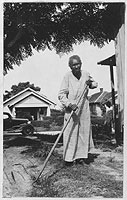
Lou Turner, Age 89
Should the Slave Narrative Collection Be Used?
 Lou Turner, Age 89 |
Given the myriad problems of authenticity and reliability surrounding the interviews, one might despair of using them at all. Indeed, until the 1970s they were not widely used in a serious fashion by scholars. The reservations concerning their use were summarized by David Henige, who, after a cursory discussion of the context within which the interviews were obtained, concludes that "the combination of weaknesses that characterizes the ex-slave narratives restricts their reliable data to such matters as childhood under slavery, some aspects of family life, some details on slave genealogies, and some unintended insights into the nature of memory and of interview psychology...." Therefore, he contends, the Federal Writers' Project effort to preserve the life histories of the former slaves "was largely an opportunity lost."30
However, a blanket indictment of the interviews is as unjustified as their indiscriminate or uncritical use. Each kind of historical document has its own particular usefulness as well as its own inherent limitations for providing understanding of the past. The utility of the ex-slave interviews can only be determined in the context of the objectives of the researcher. For example, if one is interested in entering the perennial debate over the profitability of slavery, information obtained from the narratives will be highly impressionistic and much less valuable than that from other sources such as plantation records. Yet if one wishes to understand the nature of the "peculiar institution" from the perspective of the slave, to reconstruct the cultural and social milieu of the slave community, or to analyze the social dynamics of the slave system, then these data are not only relevant; they are essential. That is not to imply that they should be used exclusively or without caution. Yet the hazards of attempting to comprehend slavery without using them far outweigh the limitations of their use.31 Saidiya V. Hartman has recently undertaken a penetrating assessment of the Slave Narrative Collection's utility. With all their limitations, she asks,
How does one use these sources? At best with the awareness that a totalizing of history cannot be reconstructed from these interested, selective, and fragmentary accounts and with an acknowledgment of the interventionist role of the interpreter, the equally interested labor of historical revision, and the impossibility of reconstituting the past free from the disfigurements of present concerns. With all these provisos issued, these narratives nonetheless remain an important source for understanding the everyday experience of slavery and its aftermath.... I read these documents with the hope of gaining a glimpse of black life during slavery and the postbellum period while remaining aware of the impossibility of fully reconstituting the experience of the enslaved.32
NEXT: The Slave Narrative Collection and the Recreation of the African-American Past
| Slave Narratives: | An Introduction to the WPA Slave Narratives |